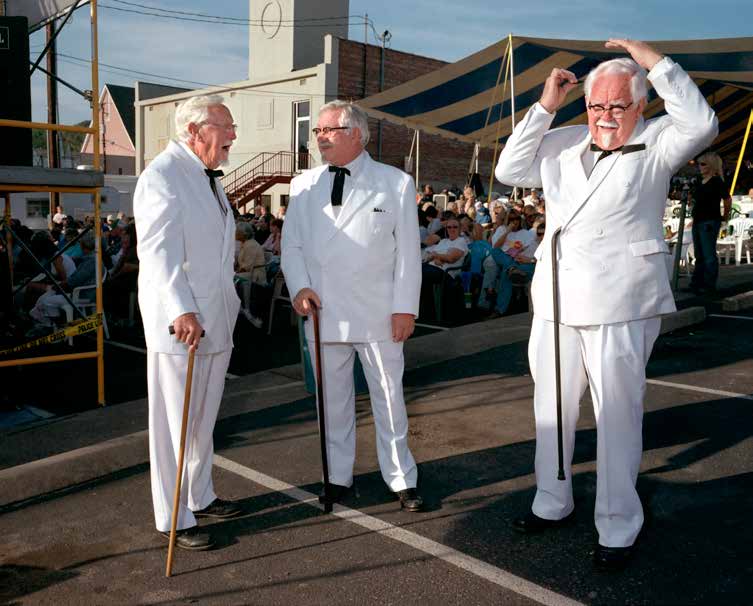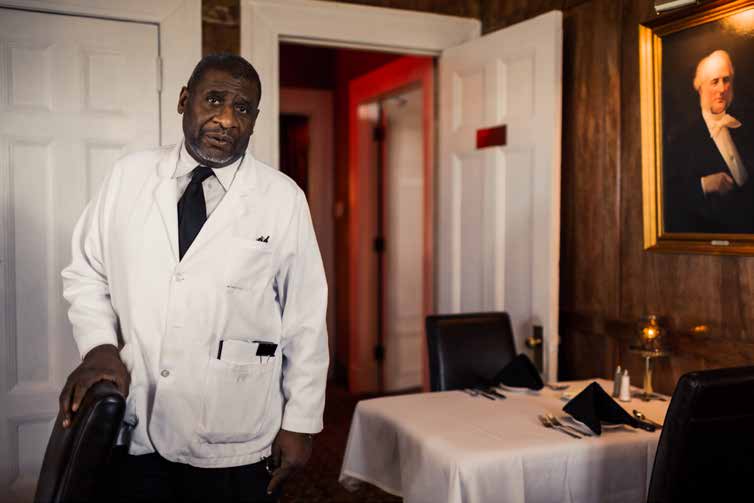Susana Raab, Finger-Lickin’ Good, 2007. From the Consumed: Fast Food in the United States series. London, Kentucky

Cloaking and Costuming the South
John T. Edge
Southerners, truth told, don’t look so good in the moonlight. And magnolias don’t offer much shade. Lies told in service of myths have cloaked and throttled the region. To obscure a peculiar history, black and white Southerners have costumed and masked. These fictions both define and project identities. Photographs, which promise honesty, sometimes make possible truer regard.
Harland Sanders was a striver. Donning a double-breasted white suit, he leveraged plantation tropes to hype and sell pasteboard buckets of pressure-fried chicken. Like Elvis Presley, another mid-twentieth-century icon of working-class culture, Sanders now lives on through impersonators, captured backstage at a Kentucky festival by Susana Raab. Robert Olden, photographed by Tamara Reynolds at Jimmy Kelly’s Steakhouse in Nashville, Tennessee, also drapes himself in white, but his garb speaks to restaurant service, not plantation leisure. Though Olden dominates the image, Reynolds directs viewers toward an oil portrait of Cornelius Vanderbilt, the shipping magnate for whom nearby Vanderbilt University was named. Squint, and you can glimpse the Kentucky Colonel’s aspirations in Vanderbilt’s lord-of-the-manor mien.
Harland Sanders developed his shtick over time. Born in Indiana to a farming family, he first gained success in the 1920s as a filling-station owner and restaurant operator in Corbin, Kentucky. In 1949, soon after Lieutenant Governor Wallace Weatherby appointed him to the philanthropic society of Kentucky Colonels, Sanders began dressing in a manner he believed would befit his new rank. Draping himself in a solemn black suit with long tails and a black vest, he fashioned a grosgrain ribbon into a necktie and stretched a watch chain across his belly. When he walked, Sanders twirled a gold-tipped cane.
Other honorees, acknowledging that their titles were honorary, framed their Kentucky Colonel certificates and mounted them in dens and home offices. Sanders, who rose to fame selling a modern version of a traditional dish associated with black cooks, embraced his election and began introducing himself as Colonel Sanders. He aimed to project stature and seriousness, qualities in short supply for a man who had begun plowing furrows with a team of mules when he was eleven. His iconic white suit and bleached goatee came later, as Sanders pivoted from selling gasoline and fried chicken to selling conceits rooted in antebellum fantasies.

Tamara Reynolds, Jimmy Kelly’s Restaurant, 2014. From the Southern Route series. Nashville, Tennessee
Sanders made his first fortune peddling a recipe for a spiced breading mix and a technique for frying chicken. Beginning in the 1950s, Sanders traveled the country to sell his cookery system. He was an able salesman, inclined toward flourishes. To win a restaurant account, after cooking chicken in the back, Sanders would take off his apron, don one of his white suits, and return to the dining room to glad-hand and cajole and close the deal. He called this performance “colonelizing.”
After Kentucky Fried Chicken went public in the 1960s and the company grew into a national and then international chain, Sanders no longer colonelized at openings. Instead, his face, framed by a bleached white goatee, black-rimmed wire glasses, and that spotless white suit, projected the necessary image. To reinforce the message over the decades to come, the company he founded plastered his face on buckets and boxes and built a white-columned, plantation-sendup headquarters on the suburban fringe of Louisville, Kentucky.
Media scholar Tara McPherson has argued that the South is “figured via a stock set of recurring icons, characters inhabiting stage sets of imagined gentility and charm.” One of the signal icons in that roster has proved to be Sanders, who secured his reputation in the years between the 1954 Supreme Court decision in Brown v. Board of Education of Topeka and the 1964 Civil Rights Act, which forced federal desegregation of our nation’s restaurants, while shilling an antebellum narrative of white leisure enabled by a coreced black workforce.
Sanders’s plantation comportment now seems archaic, yet recent KFC commercials, which feature celebrity Colonel impersonators as comic brand spokespersons, speak to its endurance. So do other references, now broadcast across the American spectrum. In bewhiskered pomposity, Colonel Sanders recalls Colonel Reb, the now defrocked mascot who once colonelized with white alumni at University of Mississippi football games. After the university dissociated itself from that colonel, those instincts found other outlets.
When the Chancellor’s House opened in Oxford in 2017, the boutique hotel invited guests to “step back into a grander, gentler time where seamless luxury service and gracious living meet rich Southern traditions.” Promotional materials made no mention of the late Colonel Reb, but in Oxford where I live, and on the University of Mississippi campus where I work, he forever remains just beyond the frame, a subaltern symbol of white leisure, unsullied by the grime of labor and the realities of history.
In her photograph, Susana Raab signals toward those ongoing performances, capturing three Colonel Sanders impersonators primping and joking before they take the stage at a festival in London, Kentucky. This is a postmodern moment, absent the need for absolute truth. Instead of leaning into his cane, pretending to rely on a prosthesis, one performer has hooked a walking stick into the V of his jacket so that he can more easily run a comb through his hair. These impersonators are in on the scheme, attuned to the pomp and tenets of colonelizing. And so are we viewers.
Robert Olden, his stance confident, his expression wary, has for thirty-plus years delivered ribeyes, old fashioneds, and bonhomie to the burghers and politicians who gather nightly at Jimmy Kelly’s Steakhouse in Nashville. Photographer Tamara Reynolds frames him with a wide shot that includes that oil portrait of Commodore Vanderbilt, whose baronial presence suggests a kind of biracial interdependence. Extend that metaphor, and we land in the lap of Paula Deen, the restaurant owner and television personality who rose to fame while trafficking in Southern stereotypes.
In a 2013 deposition that made news for her related use of a disgusting racial epithet, Deen confirmed that she had long imagined an ideal plantation-style wedding, with her guests attended by middle-aged black men wearing white jackets and black bowties. Her testimony makes clear that Deen regarded these men as props, human backdrops for a white Southern pageant. Their presence would, by her reckoning, confer social order and affirm black subservience. Writing in 1904 about a preference among white restaurant-goers for black waiters, a black waiter named A. E. Maccannon explained the Deen instinct: “[An] intelligent polished piece of ebony is just the thing needed to give force of contrast to the marble guests.”
Uniforms serve societal purposes. Livery can democratize, cloaking people of different classes and telegraphing equity. Costumes also delineate who is servant and who is served. White waiter jackets like the one Robert Olden wears speak to the easy interchangeability of personnel, especially when the servants are black and those being served are white. The history is long and ugly: during the era of enslavement, black labor was literally interchangeable, bought and sold to meet the mercurial needs of slave owners.
Tamara Reynolds delivers a comparable contrast between ebony and (ivory) marble in her photograph, but she does not suffer Deen’s view. She presents Olden with the dignity he has garnered while walking the floor nightly, two ballpoint pens in his breast pocket and an order pad tucked in his bottom blouse pocket. Her portrait counterpunches Deen’s attitude, demanding recognition for the man behind those probing eyes.
Compelled by Reynolds’s work, I recently dined at Jimmy Kelly’s. My ribeye was a bit sinewy but an old fashioned hit the mark. And my conversations with the white-coated servers proved revealing. Robert Olden did not wait on our table. Fred Lee, a veteran of forty-plus years, did. After I drained my cocktail and asked for a glass of red wine, he said, “I can do that.” What I heard was a declaration that he didn’t have to do that. What I heard was, There are things I won’t do. Later, when Olden stopped by our table, he told me about his love of jazz, and about how he travels to festivals with a video camera to record his favorite musicians. Olden made it clear that, while he values his role, he’s more than a one-dimensional icon.
In addition to marking who serves and who receives, costumes like the one Olden wears are a kind of armor, protecting the wearer from incursion, establishing social and cultural barriers. Booker Wright, who waited tables at the restaurant Lusco’s in Greenwood, Mississippi, during the Jim Crow era, wore his white jacket like a cloak. Serving broiled pompano and ribeyes and fried onion rings to the Delta cotton gentry, he relied on that barrier to protect himself, his family, and his sanity. When he let that barrier drop during a 1965 NBC News interview, he embraced vulnerability.

John Lusk Hathaway, Olivia, 2011. From the One Foot in Eden series. Tiger Creek, Roan Mountain, Tennessee
“Some people is nice, some people is not,” he said of his white customers, many of whom were cotton planters who profited from black labor. Wearing a white jacket, with a white towel draped over his left arm, alternately acting out the roles of a subservient black waiter and an overbearing white patron, he confessed that their words and actions hurt. “But you have to smile,” he said, “although you’re crying on the inside. Although you’re wondering, ‘What else can I do?’”
Looking directly into the camera, Wright declared, “I got three children. I want them to get an education…. Night after night, I lay down and I dream about what I had to go through. I don’t want my children to have to go through with that. I want them to be able to get the job that they’re qualified for. That’s what I’m struggling for.”
Just as Cornelius Vanderbilt acts as a backdrop for Olden, so does the story of Booker Wright. It would be unfair, however, to compare Robert Olden to Wright. They hail from different eras and from different corners of the South. What is more, Olden’s life, revealed in our tableside conversation, illustrates his capacity to act independently, choose freely, and live gracefully. His gaze invites us to look closely. If we aim to apprehend the South, photographer Tamara Reynolds implies, we can no longer look away, nor can we stereotype. In truth, we never could.
Of late, I’ve been thinking about the roles and responsibilities of writers and photographers and other narrative-makers who live and work in the South, or somehow tell stories of the region and its people. Near as I can tell, my role as writer is to regard the region with honesty, taking into account past errors of fact and omission and interpretation. My responsibility is to profess my biases and acknowledge my blind spots while excising and rewriting those Southern narratives that have cloaked truths and throttled progress.
My intent here is to stare down lies told and illuminate truths untold. Working with photographs and with photographers, reading their intents and outcomes like texts, seeing past costumes and masks, I recognize fellow travelers, regarding this place and its people with all the righteousness we flawed humans can shoulder.


